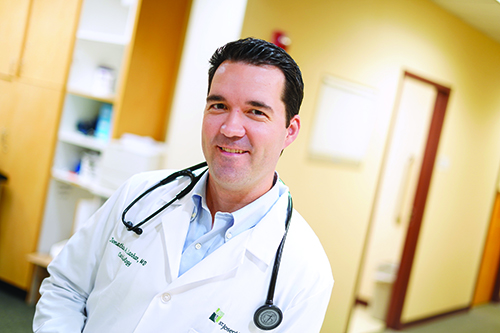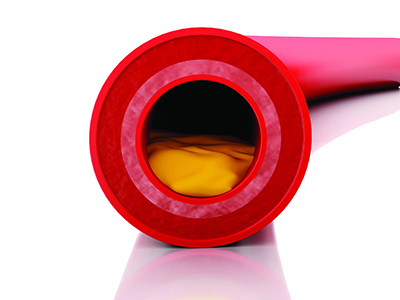Straight To The Heart
The most common type of heart disease involves the arteries that lead to it
For a long time, it’s been at the top of the charts.
Heart disease remains the number 1 cause of death in the United States. But what does it really mean to say the heart has disease? The term actually refers to several types of heart conditions, but for the most common type, the problem is in the coronary arteries. A better understanding of what is happening inside those arteries can help keep you from becoming a heart disease statistic.

Interrupting The Flow
“Coronary arteries are the main vessels that supply oxygenated blood to the heart muscle,” explains cardiologist Jonathan Lanham, MD, of St. Joseph’s/Candler’s Physician Network – SouthCoast Cardiology.
Like all organs in the body, the heart needs a continuous supply of oxygen and nutrients to function properly. A decrease in the flow can affect not just the heart muscle but also its ability to pump blood to the rest of the body.
“Plaque buildup in the artery walls can restrict and sometimes block the flow of blood,” Dr. Lanham says. “This is the cause of coronary artery disease, or CAD.”
Plaque is made up of cholesterol and other substances in the blood, and its buildup is very common.
“The buildup of plaque can be asymptomatic until it reaches a critical threshold, where the demand of the heart exceeds the amount of blood flow that can get there,” Dr. Lanham says.
Building Blocks
With about 70 percent blockage, patients with CAD may experience:
- Angina, or chest pain and discomfort
- Shortness of breath
- Pain or pressure that travels from the chest to the arm or jaw
- A feeling of fullness or similar to indigestion (heartburn)
Many of these symptoms come with exertion and are relieved by rest. Though not an emergency, these symptoms are warning signs that you need to be seen by a doctor.
A myocardial infarction, or a heart attack, usually comes without warning. CAD can lead to a heart attack, even from a plaque blockage of only 30 to 40 percent.
“Milder plaque can become thin and rupture open,” Dr. Lanham explains. “Platelets accumulate around that rupture, forming what we call a platelet plug, and can instantaneously cause a 100 percent block, which is an emergency.”
A heart attack is sometimes a person’s first indication that they have coronary artery disease. Asymptomatic cases are often found when physicians may be looking for something else, perhaps on a CT scan, and find the plaque buildup.
Once diagnosed, CAD is often treated with medications that can help stabilize buildup in the arteries. In more severe cases, surgery may be needed. Procedures for CAD include bypass surgery, in which a healthy blood vessel is grafted to the coronary artery past the blockage site, creating a new path for blood flow, or an angioplasty, in which a tiny balloon is guided into the artery and then widened to enable blood flow.
Interrupting The Interruption
Genetics can play a part in plaque buildup, and most people will have some degree of buildup as they age. However, CAD can be affected by several modifiable risk factors. That means there are several things you can do today to prevent coronary artery disease.

Dr. Lanham teaches his patients about Life’s Simple 7, a list of lifestyle changes developed by the American Heart Association for achieving excellent cardiovascular health. Not surprisingly, this common-sense list can also help prevent other chronic diseases and ailments:
- Manage blood pressure.
- Control cholesterol.
- Reduce blood sugar.
- Get active.
- Eat better.
- Lose weight.
- Stop smoking.
“Risk factors tend to build on each other,” Dr. Lanham says. “A person who is sedentary, or inactive, may gain an unhealthy amount of weight, which could lead to a rise in their blood sugar, blood pressure, and cholesterol.”
The inverse is also true, meaning that someone who is concerned about CAD can begin with just one or two risk factors. For example, eating more fruits, vegetables, and whole grains while cutting down on processed foods, sugar and red meat will not only affect your weight, but it will also help you manage blood sugar and cholesterol.
“As you build on following these seven guidelines, your risk is dramatically reduced,” Dr. Lanham says.